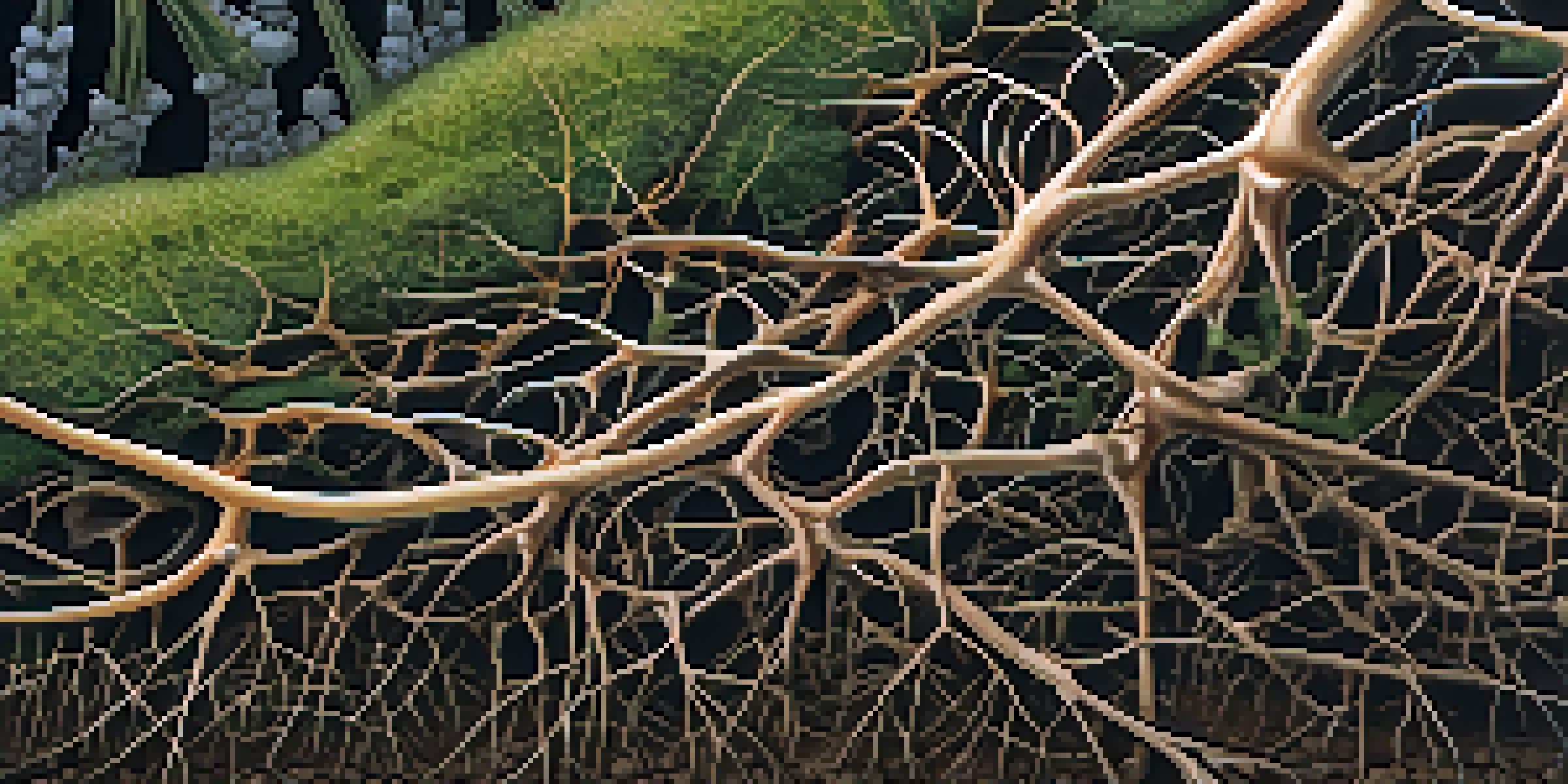The Importance of Mycorrhizal Fungi in Plant Ecosystems

Understanding Mycorrhizal Fungi and Their Types
Mycorrhizal fungi are fascinating organisms that form symbiotic relationships with plant roots. There are two main types: arbuscular mycorrhizal fungi (AMF) and ectomycorrhizal fungi (EMF). AMF penetrate the root cells, while EMF form a protective sheath around the roots. This partnership is not just beneficial; it's essential for the health of many plants.
The health of our soil is the foundation of the health of our ecosystems.
These fungi help plants absorb nutrients, particularly phosphorus, which is often in short supply. By extending their networks into the soil, they access nutrients that plants cannot reach alone. This enhances plant growth and resilience, making mycorrhizal fungi crucial for successful gardening and agriculture.
Understanding the role of these fungi is key for anyone interested in sustainable practices. By appreciating how they function, we can promote healthier ecosystems that support diverse plant life. It's a reminder that nature's systems are interconnected in ways we are just beginning to understand.
The Nutrient Exchange: A Mutual Benefit
The relationship between mycorrhizal fungi and plants is a classic example of mutualism, where both parties benefit. While fungi provide essential nutrients to plants, plants supply carbohydrates produced through photosynthesis. This nutrient exchange creates a thriving environment for both organisms, fostering growth and health.

For instance, plants that partner with mycorrhizal fungi often exhibit increased drought resistance. The fungi enhance the plant's ability to access water and nutrients, allowing them to survive in less-than-ideal conditions. This is particularly important in regions facing climate challenges.
Mycorrhizal Fungi Enhance Plant Growth
These fungi improve nutrient absorption and drought resistance in plants, making them essential for healthy ecosystems.
Such partnerships illustrate nature's efficiency and resilience. By understanding this dynamic, we can learn to appreciate the delicate balance of ecosystems and the importance of preserving mycorrhizal relationships for future generations.
Enhancing Soil Health Through Mycorrhizal Networks
Mycorrhizal fungi play a pivotal role in improving soil health. Their hyphae, or thread-like structures, create an extensive network in the soil, improving its structure and aeration. This not only facilitates better water retention but also promotes the growth of beneficial microorganisms.
In nature, nothing exists alone.
Healthy soil is the foundation of a thriving ecosystem. When mycorrhizal fungi are present, they help bind soil particles together, preventing erosion and maintaining soil fertility. This is crucial for sustainable agriculture, as it leads to healthier crops and reduced need for chemical fertilizers.
In essence, mycorrhizal fungi act as nature's soil engineers. By investing in soil health through these fungi, we can cultivate more resilient ecosystems and ensure the long-term productivity of our agricultural lands.
Biodiversity and Mycorrhizal Fungi: A Symbiotic Relationship
Mycorrhizal fungi are key players in promoting biodiversity within ecosystems. Their networks connect various plant species, allowing for the exchange of nutrients and information. This interconnectedness helps maintain plant diversity and enables ecosystems to adapt to changes.
For example, forests with diverse plant life benefit greatly from mycorrhizal networks. The fungi facilitate communication between trees, sharing resources and even warning signals about pests. Such interactions enhance the resilience of the forest and its inhabitants.
Fungi Promote Soil Health and Biodiversity
Mycorrhizal networks improve soil structure and connect various plant species, fostering a diverse and resilient ecosystem.
By fostering biodiversity, mycorrhizal fungi contribute to healthier ecosystems overall. Protecting these fungi means protecting the myriad of species that depend on them, highlighting the importance of conservation efforts in maintaining ecological balance.
The Role of Mycorrhizal Fungi in Carbon Sequestration
Mycorrhizal fungi also play a significant role in carbon sequestration, a vital process for combating climate change. By aiding plants in capturing carbon dioxide from the atmosphere, they help store carbon in the soil. This not only reduces greenhouse gases but also enhances soil fertility.
When plants photosynthesize, they convert carbon dioxide into organic compounds. Mycorrhizal fungi then assist in transferring some of this carbon back into the soil, where it can remain for long periods. This creates a natural buffer against climate fluctuations.
Understanding the impact of these fungi on carbon dynamics is crucial in our fight against climate change. By promoting practices that support mycorrhizal populations, we can enhance carbon storage and contribute to a healthier planet.
Threats to Mycorrhizal Fungi and Ecosystem Impact
Despite their importance, mycorrhizal fungi face numerous threats. Habitat destruction, pollution, and the overuse of chemical fertilizers can disrupt their delicate ecosystems. These challenges not only affect the fungi but also the plants and animals that rely on them.
For instance, soil degradation from industrial farming practices can lead to a decline in mycorrhizal populations. This, in turn, reduces plant health and biodiversity, creating a ripple effect throughout the ecosystem. It's a stark reminder of how interconnected our natural world truly is.
Threats to Fungi Impact Ecosystem Health
Habitat destruction and chemical use threaten mycorrhizal fungi, leading to declines in plant health and biodiversity.
Addressing these threats requires a concerted effort from individuals, communities, and policymakers. By advocating for sustainable practices and protecting natural habitats, we can help preserve mycorrhizal fungi and, by extension, the health of our ecosystems.
Practical Ways to Support Mycorrhizal Fungi in Gardens
Supporting mycorrhizal fungi in your garden is easier than you might think! One effective method is to avoid using chemical fertilizers and pesticides, which can harm fungal populations. Instead, opt for organic alternatives that nurture the soil and its inhabitants.
Planting a diverse array of species can also encourage a robust mycorrhizal community. Different plants form relationships with various fungi, so a mix of flowering plants, herbs, and vegetables can foster a vibrant ecosystem. This diversity not only supports fungi but also benefits your garden's overall health.

Lastly, consider adding organic matter like compost or mulch to your soil. This practice enhances soil structure and provides a habitat for mycorrhizal fungi to thrive. By making these small changes, you can contribute to the health of your garden and the vital ecosystems around you.